Best In-Ear Monitors in 2024: The Music for Your Ears
Updated: September 12,2023
Have you ever been to a concert or a rock show and noticed how the musicians all wear some small earpieces? Those are called monitors, and they serve the same purpose as the speakers pointed towards the performers. They let the performers hear themselves while on the stage so they can adjust their sound levels on the fly.
Whether you’re a professional musician or just starting your music career, picking the best in-ear monitors can help you significantly improve your skills. We’ve explored all the options currently on the market for both musicians on a budget and professionals seeking the very best gear that money can offer.
Shure SE215
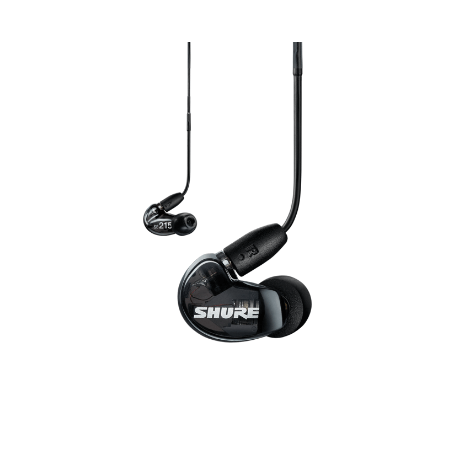
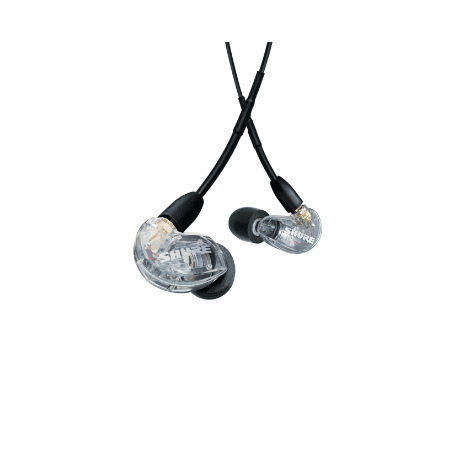
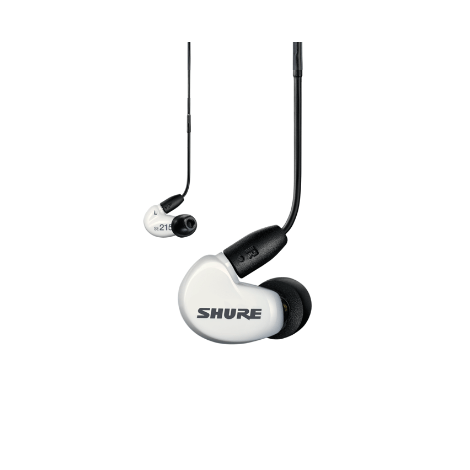
- Good audio quality for the price
- Sturdy, detachable cable
- Lightweight
- Low frequency range
A lot of music professionals will tell you one thing - you can never go wrong with Shure. The Chicago-based audio equipment manufacturer has been in this business for nearly a century, creating the most popular in-ear monitors around, so it’s safe to say its engineers know what they’re doing. In the case of SE215 IEMs, they hit it out of the park, as they are not only affordable but sound pretty good, too.
These are some of the lightest in-ear monitors around and also the most comfortable. The earpieces can be rotated in 360 degrees, you get several sets of ear tips, and the cable is very flexible but also durable since it’s kevlar-reinforced. This is also a very portable set of in-ear monitors, as the cable is detachable, and you get a handy carrying case that stores everything you get in the box.
But, how do these professional earbuds sound? The sound is pretty good, but not the best you’ll ever find. Shure’s IEMs are on the bassy side, which makes them great for casual listening. Still, if you’re looking for a pair of reference monitors for studio monitoring and music production, you might end up disappointed. Their frequency range isn’t huge compared to more premium offerings. Don’t get us wrong; the sound is still precise; it’s just not the pure audiophile experience one expects from a set of high-end monitors.
Our biggest surprise was the price of this system. Shure decided to set the SE215’s price just under $100, making it an incredible value proposition and the best in-ear monitors for musicians on a budget. Definitely a purchase you won’t regret, staying true to the brand’s reputation.
InEar ProPhile-8

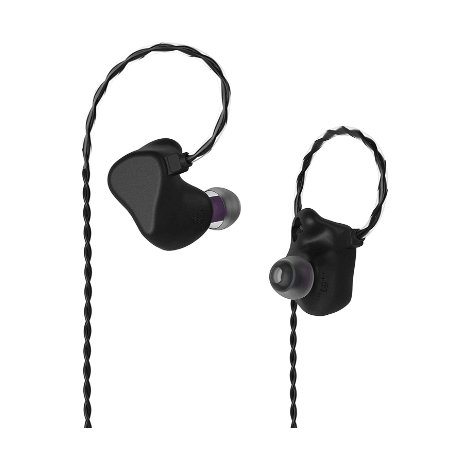

- Superb sound
- Tuned for mixing and mastering
- Unbeatable comfort
- Very expensive
We’ve talked about in-ear monitors you can buy when you’re on a budget. But, what if money’s not an issue and you can splurge more than $1,000 on a pair of buds? Well, look no further than products by InEar. This is a German company specialized in creating the absolute best in-ear monitors around. Not only are its monitors perfect for music production, but each set is handcrafted using the highest quality materials. These IEMs are the ultimate premium offering on the market.
While we’re on the topic, let’s address the elephant in the room. These earbuds are expensive. To be more precise, they’re $1,499, or 15 times the price of Shure’s model that we’ve also reviewed here. Obviously, this is well beyond the budget of amateur musicians and music listeners. You buy these if you know you’ll return your investment. That is if you’re a successful music producer or artist.
So, what’s the secret behind some of the best studio in-ear monitors that money can buy? The impressive sound quality of these earbuds is achieved by having no less than eight drivers in each earpiece, sporting a high-frequency range, and having a lot of power “under the hood.” On top of that, there are switches for changing sound signatures and boosting highs or lows when you need them the most. Producers will be able to achieve pitch-perfect audio reference with the InEar ProPhile-8, while performers can hear all the subtleties in their sound.
Aside from the high price point, there really aren’t any downsides to these in-ear monitors. They’ll fit pretty much any ear thanks to 7 interchangeable ear tips and will keep their brilliant audio quality for many years to come due to the impeccable manufacturing. There really isn’t anything like these buds out there. They are the ultimate professional in-ear monitors with a price tag to match.
Audio-Technica ATH-E70


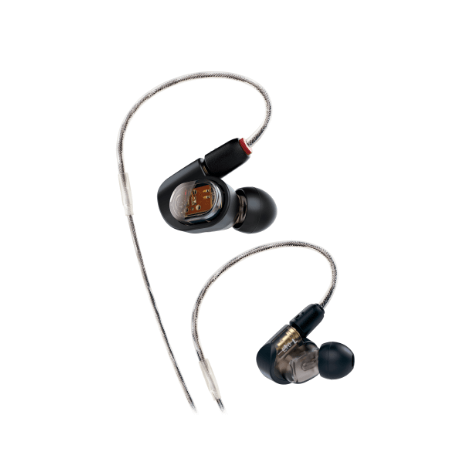
- Clean, precise sound
- Powerful and loud
- Discrete design
- Noise-canceling could’ve been better
Many DJs and live performers swear on audio equipment by Japanese manufacturers. Among the many companies that produce earphones, Audio-Technica stands out because it makes top-of-the-line hardware that doesn’t cost an arm and a leg. Such a prominent manufacturer, of course, has produced its fair share of top-rated earbuds. Today, we’ll be looking at ATH-E70, the professional-grade monitors and flagship product from Audio-Technica.
Like many similar products, the ATH-E70s are semi-transparent and don’t really give out the impression that you’re holding a piece of high-end tech. But, the moment you put them in your ears, you’ll know you’re experiencing something special. Wearing these will feel like they were made just for you. The “magic” lies within the cable itself, which is made out of a memory material that keeps the shape customized to your earlobe. Even the ear tips adapt on the go, so once you’ve put them on, it will feel like you’ve always worn them. The unmatched comfort level is why these are the best wired in-ear monitors to bring onto the stage.
Audio Technica achieved reference sound by using three drivers per earpiece, one driver each for low, mid, and high tones. The monitors also provide a lot of power, which is especially useful for live performers during loud concerts, not to mention preventing damage to the monitors when they’re connected to an amp.
Granted, these don’t come cheap, but they’re at the middle of the price spectrum in our review lineup, and you’ll get much more than you’ve paid for. If you’re looking for the best IEM under 500, the Audio-Technica ATH-E70 is the way to go.
Sony IER-M9

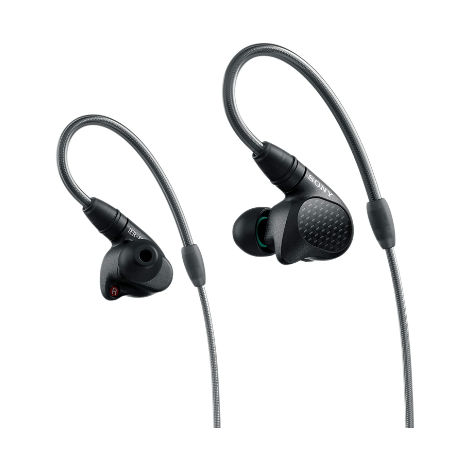
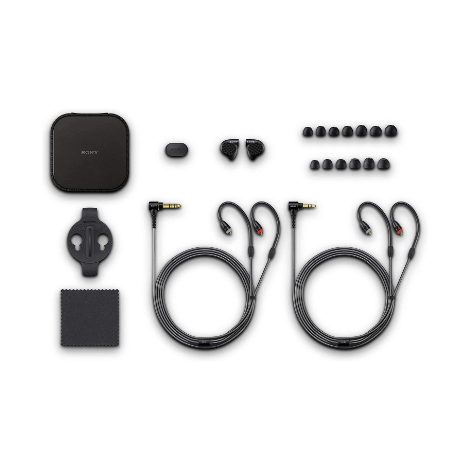
- Very high dynamic range
- Clear, precise sound
- Reliable
- Expensive
- Not as comfortable as we had hoped
We couldn’t make a list that includes Japanese audio brands without mentioning Sony. The tech giant is well known in the world of professional audio, whether through its revolutionary noise-canceling headphones, hi-fi systems, or in-ear monitors. Among several high-end models in Sony’s current lineup, the IER-M9s stand out as the best earbuds that the company has to offer.
Touted as the best choice for vocalists, these IEMs offer an impressive frequency range, beating even some more expensive models such as the InEar ProPhile-8. Sony has built a custom 5-driver setup for these monitors called Balanced Armature. The company used magnesium for most parts, including its super tweeter, designed to provide clear and crisp high notes. Even the shape helps the sound reach the performer’s ear in a linear motion, ensuring all the sounds come out as intended.
Sound quality is, in short, superb. The fantastic clarity, especially in the highs and mids, makes them some of the best in-ear monitors for singers on the market. They’re also very lightweight and made from durable materials. One thing that might not click with everyone is their shape. Sony has opted to prefabricate the ear hangers in hopes of improving comfort, but such a solution obviously won’t fit everyone’s ear perfectly. Luckily, you get 13 ear tips in two materials and lots of shapes, so at least the sound isolation and in-ear fit are top-notch. Another factor that may be discomforting is the price. To be fair, costing nearly a grand hasn’t stopped these earbuds from selling out of stock numerous times, so Sony clearly knows their value.
KZ ZST


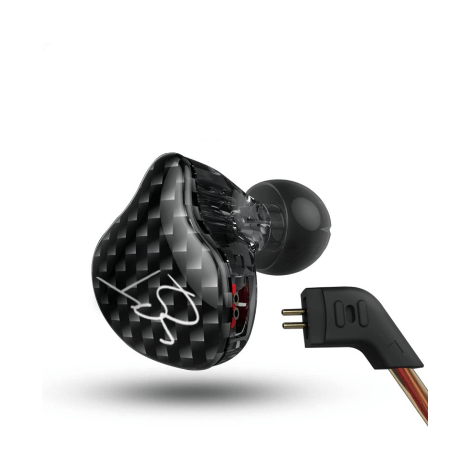
- Surprising sound quality at this price
- Detachable cable
- Easy to upgrade
- Low build quality
- Short cable
Stepping down from the ultra-premium to the ultra-affordable, we found some big surprises and excellent deals. Since not everyone can shell out hundreds (or thousands) of dollars on their first in-ear monitors, smaller manufacturers have found a perfect niche for entering this saturated market. One of them is Knowledge Zenith or KZ for short.
The Chinese manufacturer offers more than a dozen affordable earbuds, but the KZ ZST is definitely its most popular one. It is the ultimate budget choice for people that want to try out an in-ear monitoring system without breaking the bank. A pair of these shiny buds will cost you just under $20, which is a steal considering their performance. They also come in several colors and with an optional mic, so they’re handy for everyday use, not just for music performances.
Even though these can be considered “cheap” monitors, they don’t compromise on too many design aspects. The cable is detachable and has gold-plated connectors, you get three sets of silicone ear tips, and these affordable IEMs also have “Hybrid Balance Armature” drivers for improved sound quality. That being said, the casing is all plastic, so these feel like they may break at any time, and we’re sure that they won’t be able to handle rougher care on stage. Again, the KZ ZST is almost unbeatable for this price, and you can grab a few pairs as a backup. That makes them a no-brainer for beginners and people looking to get a decent pair of IEMs for a pittance.
Sennheiser IE 100 PRO Wireless


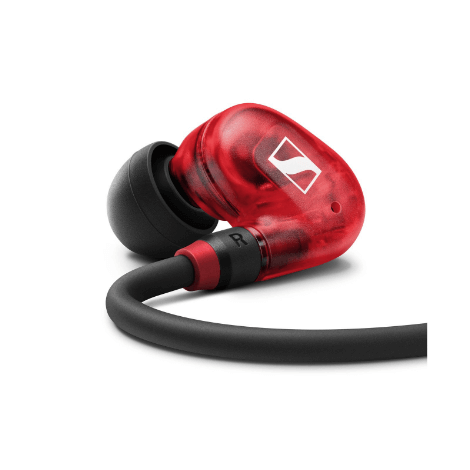
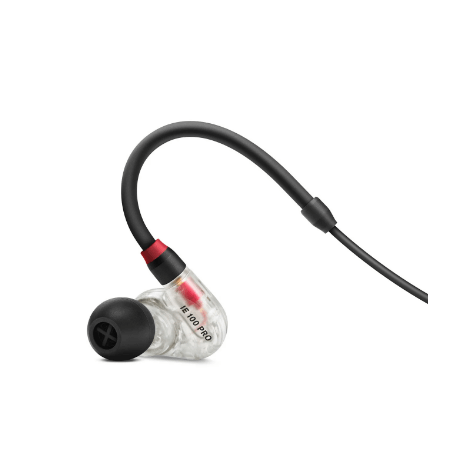
- Can be used wired or wireless
- Stage-proof cable
- Good sound isolation
- No carry case
- High tones are not punchy enough
When talking about audio hardware, specifically the best wireless in-ear monitors, we cannot forget one of the brands synonymous with high-quality audio. The brand is Sennheiser, of course, a legendary German manufacturer of everything sound-related. It has recently unveiled the IE 100 PRO in-ear monitors, an upgrade from the very successful IE 40 PRO model.
Let’s start with the basics. Sound quality is something that never disappoints with this manufacturer. Sennheiser is well known for its signature warm sound, but without compromising any detail in the sound stage. These Bluetooth in-ear monitors are on par with what we’ve got accustomed to, making them ideal for both everyday and professional use. That being said, the frequency range is more on the bassy side, so the guitar and bass players, as well as drummers, will find more use of these IEMs than choir singers.
We’ve chosen the wireless model for our list as it’s just slightly more expensive but brings Bluetooth capabilities into the mix, making this already versatile pair of earbuds even better. You can also go with the $99 version that’s fully wired and upgrade later on by purchasing a Bluetooth kit from Sennheiser. As with the best IEM solutions around, battery life is excellent. Fully charged, the battery should last you about 10 hours, which is more than enough for any gig, including long DJ sessions at festivals. And, since it uses Bluetooth, you won’t have to worry about compatibility with other hardware.
One grievance with these in-ear monitors is the lack of a carrying case. Sennheiser gives out just a cloth bag, forcing customers to spend more money on a more secure storage solution. Even though these earbuds are highly durable, you still need a proper carry case to ensure that they won’t get damaged in transport. Quality-wise, buds may be the best in-ear monitors for live performance in their price range. With that in mind, omitting the carry case is a major misstep in our book.
Shure PSM 300

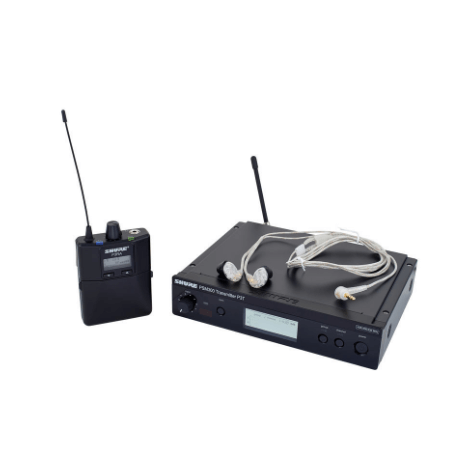
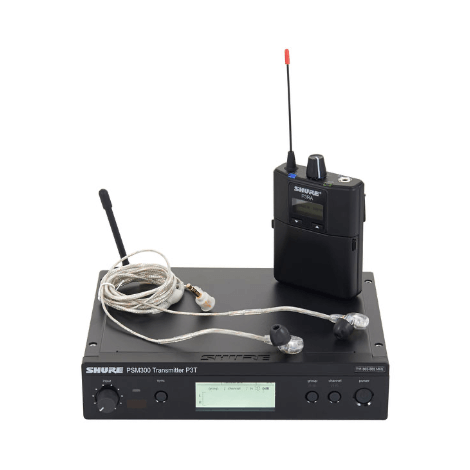
- Easy to set up and use
- Highly expandable system
- Lots of settings
- Battery life isn’t great
Some concerts and festivals boast such massive stages that your band might have difficulty connecting IEMs and keeping everything running smoothly. This is especially problematic if you have people running around the stage, diving into the crowd, or you simply don’t want a river of cables cluttering up the stage. The solution? A wireless in-ear monitor system for a band, such as the Shure PSM 300.
The system comes as a three-part set. You get the in-ear monitors, of course, a belt pack that the earbuds connect to, and a transmitter device. Shure allows for mixing and matching of components when ordering this set, so you can easily upgrade it. It covers the 500 MHz band, and Shure’s website has a handy tool for checking which frequencies aren’t used in your area by entering your ZIP code.
The PSM 300 allows two performers to sync their IEMs to the transmitter, and each of them gets their own settings on the belt pack. So, if you were looking for the best in-ear monitors for bass players that can’t stay put during a gig, this is it. Your performers can set up the mix on the fly, too. For example, the singer can boost the vocal track, or the bass player can isolate the guitars for better audio monitoring. Setting this all up, and we can’t emphasize that enough, is incredibly simple, and Shure’s system is unbeatable when it comes to ease of use. You don’t need to be a sound engineer to operate the PSM 300.
This system uses AA batteries for its belt packs, and they, unfortunately, don’t last as long as batteries on other top earbuds. On average, a pair of alkaline batteries will provide power for up to five hours, so either have multiple batteries on-hand or get a rechargeable pack from Shure. That’s the only significant downside of this otherwise exceptional kit.
MEE Audio M6 PRO
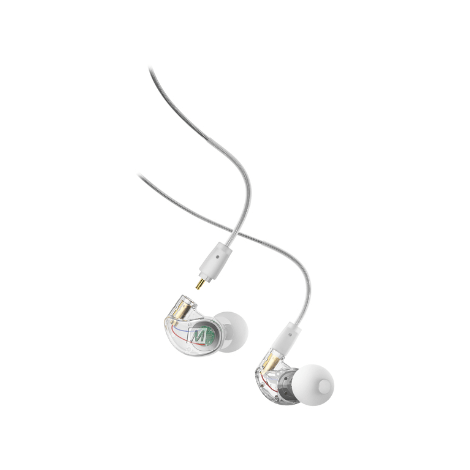
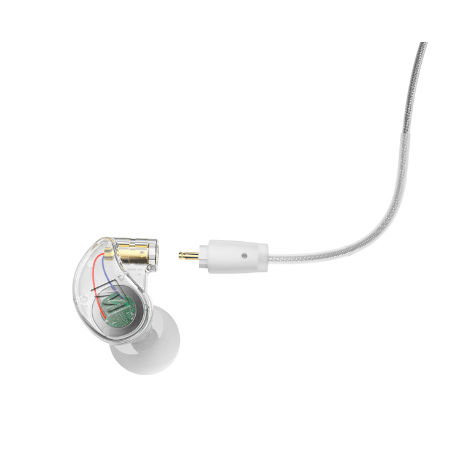
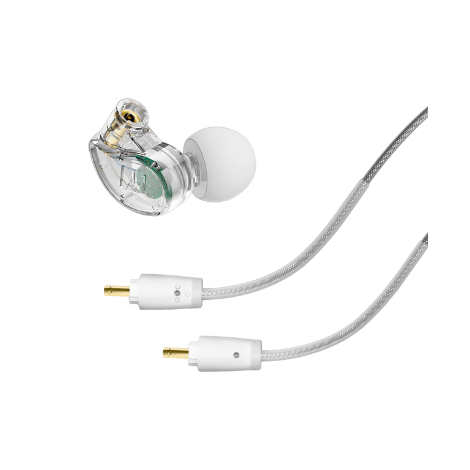
- Deluxe packaging at an affordable price
- Good sound isolation
- Available in a variety of colors
- Better options are available if you spend a bit more money
It’s hard to find the best in-ear monitors for drummers, but these earbuds are definitely a solid budget consideration. The second edition of MEE Audio’s M6 PRO monitors improves on an already solid piece of audio tech. Best of all, the affordable price point was maintained even with the upgrades, making it one of the best purchases that an aspiring musician can make. While M6 PRO can’t really match the more expensive premium systems, it does manage to punch above its class.
A lot of musicians were already impressed by the previous model, but for MEE Audio, it simply wasn’t enough. The company’s engineers further refined the audio formula, emphasizing mid and high tones, thus improving the precision of audio reproduction in MEE’s most popular earbuds. The bass is also a bit punchier but not quite at the level found on good consumer headphones. You’ll still hear the music as intended by the artist, not the overblown audio meant to impress the casual listeners.
The most pleasant surprise comes from the packaging. In a neat hard case, you’ll find an additional cable with an inline mic for using these IEMs with your smartphone. There are also many additional silicone ear tips in various sizes, a pair of noise-canceling foam tips, and a ¼” adapter for sound systems and DJ mixers. The latter is something we’re not used to seeing among even the best in-ear monitors under $200, so big props to MEE Audio here. Durability-wise, these are really great. While we recommend against smashing these to check whether they’re broken, you can rest assured the earpieces will stay in one piece (see what we did there?) even if dropped on concrete. The cable is also sweat-proof.
While there aren’t any glaring issues with the M6 PRO, its price falls into tricky territory. Spending just a bit more lets you enter the “big boy” SE215 territory. Likewise, you can spend less and get KZ ZST as entry/backup in-ear monitoring for drummers. The $30 price difference can’t be really felt in sound quality. You’re just paying more for a nicer package.
Top in-ear monitors in 2024
- Shure SE215
- InEar ProPhile-8
- Audio-Technica ATH-E70
- Sony IER-M9
- KZ ZST
How We Review In-Ear Monitors
Before we talk about any benefits of in-ear monitors (or IEMs), discuss different types, brands, and whatnot; let’s cover some basics first. Why would you need a pair of these earbuds in the first place, and who are they for? Musicians are the primary audience, obviously, but also podcasters and anyone who’s into sound recording, live performance, and production.
The reason why all these people need the best in-ear headphones is simple - they want to monitor their audio levels at a gig or in the studio. Hence the “monitor” in “in-ear monitors.” Singers, for example, want to get that “voice in your head” feel that lets them focus better than when using traditional monitors. Drummers and other band members won’t have to be so loud to drown out their bandmates’ sound just to hear their own instrument. As you can imagine, that can end up being a sonic tug-of-war instead of a fun gig, hurting the ears of both the performers and the audience. With in-ear stage monitors, each band member can get a clear sound and adjust their mix on the fly. Not to mention that your audio guy will love you. No more peaking and causing distortions. At least, if that’s not your band’s schtick. You do you.
What to Look For When Choosing In-Ear Monitors
So, you’ve realized you’ll need to grab a par or few of these snug-fitting earbuds. You’re shopping around, finding a wide range of prices and builds. Pretty much anything from $15 to $1,500. Worst of all, these all kind of look the same. But, there are some significant differences and reasons why a pair of audiophile earbuds that sits in the 4-digit range is worthy of its hefty price.
First and foremost, you’ll need to decide whether you want a fully wired or a wireless set. Both have their advantages and disadvantages. Wired monitors can be purchased on the cheap, especially the entry models. They don’t require batteries or extra maintenance, but they do restrict the movement of the performer. They’re great for drummers, while for the rest of the band, you’ll probably want to grab some wireless monitors. Do note that wireless setups can end up costing a lot, especially if they don’t come with rechargeable batteries. On the other hand, having a central unit for controlling the whole in-ear monitor kit and giving artists the freedom to move around on the stage is well worth the price premium that these units often retail for.
You’ll also want good sound isolation. If the external audio “bleeds” in, the performer will have a hard time hearing themselves, thus nullifying the sole purpose of in-ear headphones. The shape and type of the piece that enters your ear are very important for comfort and also an entirely personal preference. Having said that, whether a monitoring system comes with additional earpieces or what their type is, doesn’t impact our decision to recommend it as the best IEMs in their niche.
The last piece of the puzzle is impedance. It’s the number accompanied by the Omega symbol that you’ll find on most audio equipment. There’s a lot of complicated math behind it, so we’ll just summarize it quickly - the lower it is, the less power you’ll need for your equipment. However, lower impedance earphones are more prone to “blowing out” if you feed them too much power, as in turn, the volume up to eleven. An average impedance is 20 Ohm, but it can go as low as 8 Ohm. This is all-important to take into account when choosing your next in-ear monitor system. You want to have enough power for all the monitors and, at the same time, not risk damaging your audio equipment.
Our Methodology
Now that we’ve explained what IEMs are, why you might need them, and how to choose a product that fits your needs, we’ll guide you through our process of selecting the best of the best. We’ve encountered dozens of products in this niche, some great, some not so much, and comparing them became a bit of an obsession for us. While searching for the very best in-ear monitors on the market, we run each through our detailed review methodology. Here’s how we do it.
Sound Quality
Much like with speakers, the most important feature of any monitoring system is how good it sounds. There are many factors at play here that impact the sound you’ll be hearing out of your earbuds. The drivers, arguably the most essential piece of any headphone, affect this the most. Usually, the larger the drivers are, the louder the earphones can be. Modern monitors often feature several drivers, up to 10, with each driver designed for a specific frequency range. That way, the manufacturers can produce crisper and more precise sound in their top in-ear monitors. Of course, there are exceptions to this rule, and we’ll point them out in our reviews.
Let’s get one thing clear: the frequency range absolutely matters. If the monitors struggle with lower frequencies, they won’t be of much use to bass players or vocalists covering the lower octaves. Similarly, a lack of high frequencies means that you won’t be getting the full soundstage from your earbuds. While neither of these will make your in-ear monitors completely unusable, the best monitoring earbuds on the market deliver exceptional frequency ranges.
Durability
Stage equipment is prone to a lot of wear and tear. Earpieces can drop on the ground, get smashed against an instrument, or get tossed into a case where they tumble around with other hardware. Good build quality is, therefore, imperative. We don’t want our expensive audio gear to break easily, even if someone steps on it. On wired sets, the cable should be sturdy and feature additional isolation to protect against wear and tear. Ideally, the cables should be detachable, providing easier storage for your gear.
In the case of wireless setups, such as with wireless speakers, battery life and range are two very important factors. Since the mixing booth is usually far from the performers, we’re looking for wireless in-ear monitors and setups that can cover a lot of ground and work on multiple frequencies to prevent interference. Likewise, batteries in each set should last for the whole duration of the performance and some more. It’s always good to have a buffer instead of getting a set that has just enough juice to last for the duration of your gig. So, anything with 5+ hours of battery life is golden.
Value
Even when money’s not a problem, the value proposition stays an important factor in deciding what IEMs to purchase. A pair of affordable in-ear monitors may go a long way if they’re durable enough, but sometimes it’s better to go with a more expensive set if it produces better sound quality, comes with more bells and whistles, and is more robust. In that case, even a costly pair of monitors is a better value for the end-user.
We weigh all the previously mentioned features and specifications against the retail price of each monitoring system that we review. We’ll note if a specific set is a much better purchase compared to the others. All of our reviews show both the key features and pricing of the in-ear monitors in our lineup, so you can quickly find the device that fits your budget.
Frequently Asked Questions
FAQ
Professional musicians, especially the big international stars, go for the best-in-class audio devices. That includes in-ear monitors. The price is a non-issue for pros, so brands like Ultimate Ears, InEar, Jerry Harvey Audio, and Sensaphonics dominate the market. High-end for high performance is the name of the game and, if you choose any of those expensive in-ear monitors, you’ll definitely get your money’s worth.
Overly loud sounds can lead to hearing problems, regardless of whether you're using $1,000+ ear monitors or some budget-level earbuds. This is why noise-canceling is so essential when choosing monitors. The better the sound isolation is, the lower the volume you’ll need to use on your monitors. Yes, premium in-ear monitors can get expensive, but it’s a small price to pay compared to hearing loss or tinnitus.
Ear monitors are designed to provide as accurate a sound stage as possible. As such, the best IEM under 200 USD will probably offer a much more realistic sound than similarly-priced headphones, but that doesn’t mean it will sound as good subjectively. Now, for studio and personal use on a higher budget, you can go with whatever’s more comfortable. If you’re performing live, though, IEMs are the way to go. They’re discrete and provide better soundproofing while offering similar quality sound compared to classic headphones.
Considering that they’re made for hearing music during a performance, yes, absolutely. That being said, you might be disappointed with your music collection if it’s not well recorded. These types of earbuds really shine with Hi-Fi audio, as they’re not designed to enhance recordings, just reproduce them realistically.
Yes, if you can afford them. Getting any piece of equipment customized can be costly, and it’s debatable whether the end result would produce the best in-ear monitors for you. So, if you’re not absolutely certain that you need custom monitors and aren’t willing to shell out a premium on them, it’s better to pick any of the high-end models featured in this article.
Your email address will not be published.
![$row['title'] - image](https://trinity-core-s3.s3.us-west-1.amazonaws.com/kommandotech/1942/Shure-SE215-black.png)
![$row['title'] - image](https://trinity-core-s3.s3.us-west-1.amazonaws.com/kommandotech/1943/inear-pro-phile-8-paired.png)
![$row['title'] - image](https://trinity-core-s3.s3.us-west-1.amazonaws.com/kommandotech/1948/ATH-E70-paired.png)
![$row['title'] - image](https://trinity-core-s3.s3.us-west-1.amazonaws.com/kommandotech/1954/Sony-IER-M9-closeup.png)
![$row['title'] - image](https://trinity-core-s3.s3.us-west-1.amazonaws.com/kommandotech/1955/KZ-ZST-paired.png)
![$row['title'] - image](https://trinity-core-s3.s3.us-west-1.amazonaws.com/kommandotech/1956/Sennheiser-IE-100-PRO-closeup.png)
![$row['title'] - image](https://trinity-core-s3.s3.us-west-1.amazonaws.com/kommandotech/1957/Shure-PSM-300-front.png)
![$row['title'] - image](https://trinity-core-s3.s3.us-west-1.amazonaws.com/kommandotech/1958/MEE-Audio-M6-PRO-paired.png)